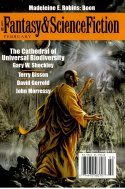
| Editor: | Gordon van Gelder |
| Issue: | Volume 110, No. 2 |
| ISSN: | 1095-8258 |
| Pages: | 162 |
This issue seemed shorter than most. It's the same page count, but much of the issue was taken up by the second part of Terry Bisson's fast-reading but not particularly good serial Planet of Mystery. Thankfully, that was the low spot of the issue; everything else ranged from okay to quite good. Charles de Lint even reviewed a surprisingly interesting set of books this issue.
"The Cathedral of Universal Biodiversity" by Gary W. Shockley: I'm not sure what to think of this one. The setting is compelling: a monk in a terraformed environment who thinks up possible types of life that humans may find in space. There's a touch of self-reference to SF authors but a deeper appreciation of both the sort of odd edges people find useful in religion and the focuses of belief. The monk is interrupted by an obnoxious rich woman who buys part of his world to host parties, and then turns into a clash between spirituality and materialism that has a somewhat stock ending. I think I would have liked this more with more plot and more of a resolution to the ending, but the characterization wasn't bad. (6)
"The Long and the Short and the Tall" by John Morressy: I liked one of Morressy's previous stories of Kedrigern the wizard. It's fantasy with a bit of a satirical edge and self-conscious narration, and it moves right along. This time, Kedrigan is off to find the lost belt of a dwarven king, and the early exchanges are amusing and fun. Unfortunately, the story then trails off into a far-too-easy resolution without much of a sting and without much further humor. Not bad, but not at all memorable. (5)
"Planet of Mystery, Part II" by Terry Bisson: When we left our hero, he was still trying to figure out whether the Venus he crashed on was some sort of illusion or if even stranger things were happening. The second part helps neither him nor the reader, becoming more and more surreal, offering a possible threat to earth, leading to more and more unexplained events, and filled throughout with some of the most obnoxious and repetitive characterization I've read recently. I think there was something subtle going on here that I just didn't get, but I got no useful payoff from the previous section and found this month's installment simply annoying. (2)
"thirteen o'clock" by David Gerrold: This is very unusual fare for the SF magazines. It's a first-person stream-of-consciousness story with a paucity of capital letters or periods, told from the perspective of a bisexual Vietnam vet who's part of the leather culture in what feels like the West Coast, and who is coming to terms with love, his past, the pretty boy bigot that for some reason agreed to go on a date, and strange flashes that he's been getting. It's very strongly character-driven; the small bit of SFnal content is more metaphorical than anything. One has to have some patience with the experimental tone, but I thought this was excellent as a character study and a sideways attempt to talk about emotional resonance between people. (7)
"Parsifal (Prix Fixe)" by James L. Cambias: A gag story about a search for the Holy Grail that builds up to a sort of symbolic pun through conversation and richly-described food. It's short and light; you'll either smile and heh at the end or you won't. I did. (6)
"Boon" by Madeleine E. Robins: This is the best story of the issue, even if the premise sounds prosaic. A waitress and single mother who is barely keeping things together gets a mysterious boon from elves and then unexpected help from brownies. However, the elves in this story take interesting class overtones, acting like the spoiled rich with a casual disregard for humans as servants, and this beautifully sets up class conflict of a more explicit type between the elves and the brownies, with the protagonist caught in the middle. None of the plot twists will particularly surprise, and the climax one could see coming a mile away, but the story is told with such sincerity and charm that it doesn't matter. It's feel-good urban fantasy without much of an edge, but for what it is, it's quite good. (8)
Reviewed: 2006-07-01